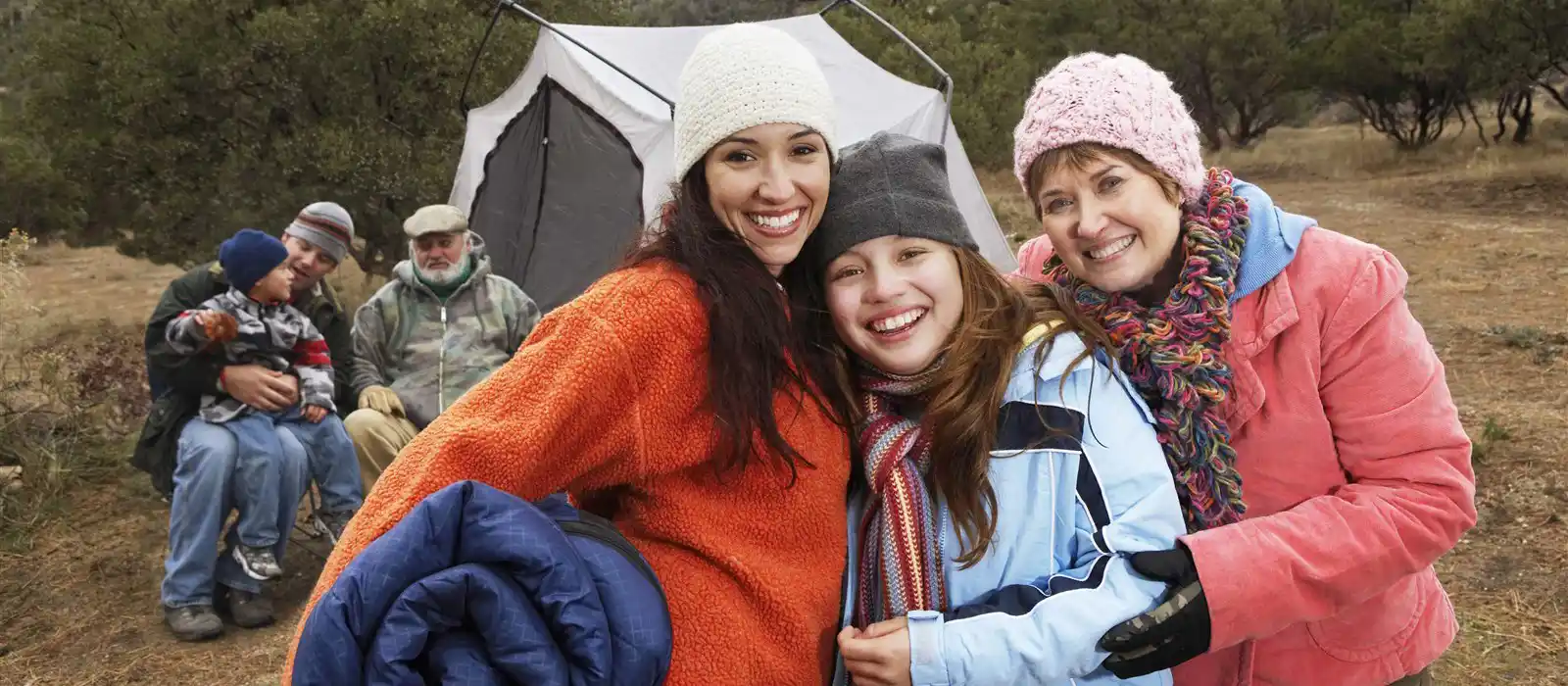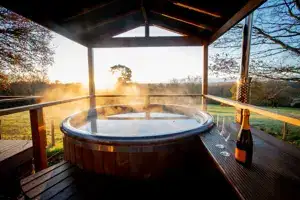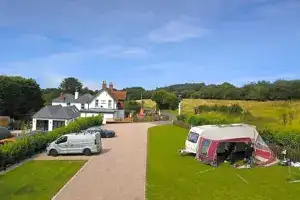There is no quicker way to ruin a camping trip than being cold, but with a bit of preparation, it needn't ever be a problem. There is a huge amount you can do to keep warm while camping, some of it obvious and some of it not so obvious.
Here's how you can stay warm and cosy when camping in a tent even on chilly nights.
Don't get cold and don't get wet
The best way to keep warm is to not get cold. Sounds pretty obvious! But once you have allowed yourself to get cold, it can be very difficult to warm up again. It is especially important to not let yourself get cold before going to bed.
The second thing to remember is to stay dry. Nothing cools you down faster than being wet, which is why sweating is so efficient at lowering our body temperatures. Always have a dry change of clothes available, change out of wet clothes immediately and wear moisture-wicking fabrics next to your skin.
Choose the right camping spot
When it comes to staying warm in a tent, the first thing to think about is setting up your tent in a suitable place. Avoiding exposed areas will reduce the cooling effects of wind and rain.
- Choose a sheltered pitch which provides windbreaks for your tent such as bushes, trees, walls or rocky outcroppings.
- Avoid camping on valley floors, because cold air sinks to the bottom of a valley and water will also gather or flow here.
How to keep warm camping in a tent
Insulation, insulation, insulation!
One of the most important things to remember is to provide good insulation between you and the ground, both when sitting outside or sleeping in your tent. Apart from in winter, the ground will normally be colder than the air and will drain heat from you. The key to insulation is layers - the more layers the better. Air mattresses, self-inflating mats, thick foam camping mats, rugs and heavy blankets all make good bases for your bed.
The best way to keep warm at night is to have your bed raised up off the floor, for instance by using a camp bed.
You should then insulate both below and above your base with an extra layer. Put an extra layer between your sleeping base and the ground (an insulated picnic blanket works very well for this, as does cardboard or a piece of old carpet) and between your sleeping base and your sleeping bag. A fleece blanket will be warm and will stop your sleeping bag sliding around too much.
Then you can put extra blankets or a duvet on top of your sleeping bag if needs be.
It may sound counter-intuative, but it's also important to make sure that there is adequate ventilation in your tent. Your body heat and breath will cause condensation in a tent and water droplets will make you colder. Having a well-ventilated tent will help to prevent condensation, so keep those vents open.
How to keep warm in a sleeping bag
There are different kinds of sleeping bags available to suit different seasons and temperatures so make sure the one you have is good quality and suitable for the temperatures you'll be camping in. You can also get sleeping bag liners that provide extra warmth. These are a great idea, they are easy to wash and can also be used alone if it gets hot when camping in the summer.
Fluff up your sleeping bag before going to bed so the fibres in the material aren't flat: the air between the fibres is what holds the heat.
When your sleeping bag is not in use, it's a good idea to air it in order to get rid of any moisture that may have collected inside it overnight.
It may be tempting to breathe into the sleeping bag to warm it up and to keep your head inside the sleeping bag, but you should try to keep your nose and mouth outside - breathing moisture into the bag will cool you down. If you need to keep your head and face warm, wear a balaclava, a hat or a hoodie with the hood up.
Wear suitable clothing
You should always pack to cover the worst weather expected. You will never be sorry for bringing an extra pair of socks or a warm fleece or jumper and you'll be grateful for having a spare dry change of clothes if you get wet.
In order to stay warm and dry at night, you need to consider your clothing as well as your sleeping setup. You'll need warm clothes but having several thin layers of clothing will keep you warmer than wearing something such as a fleece over pyjamas - and it will also stop you overheating too.
Ensure the base layers wick moisture away, you do not want fabric to hold moisture next to your skin which will make you cold. Moisture-wicking fabric includes wool, silk and synthetic materials but not cotton (try to avoid cotton sleepwear as it absorbs moisture and takes a long time to dry).
You also don't want clothes to be too tight as this will reduce the insulation they provide. Thermal underwear can work well, and wearing extra socks will help significantly too.
Make sure all your clothing is completely dry before putting it on. It is a good idea to have clothing that you only use for sleeping. Even if the clothing that you wore during the day feels dry, it will still have some perspiration in it which will make it harder to stay warm.
Accessories for keeping warm
Aside from bringing extra blankets, duvets and clothing, camping accessories such as portable hand warmers and self-heating gel packs are easily available and great for keeping hands and feet warm. Hot water bottles in your sleeping bag will also work wonders!
Eat sufficient calories and drink hot drinks
When it comes to staying warm, it is important to eat enough calories because your body needs energy to produce heat. High calorie meals will help keep you warm - and you may want to keep some snacks close to hand in case you wake up cold during the night.
Make sure you stay well hydrated during the day too, though don't drink a lot of fluids right before you go to bed as you won't want to go to the toilet during the night. Getting up means losing all the heat you've built up in your sleeping bag. Hot drinks will help warm your core.
Get active to get warm
Staying physically active will keep you warm - going for a short walk, jumping up and down or doing jumping jacks will all warm you up quickly. Kicking your legs around in your sleeping bag won't hurt - as long as the tent is big enough!
Using campfires to stay warm
If your campsite allows campfires, then lighting one is a great way to stay warm. The usual fire safety rules should apply - keep the fire well away from any tents, never leave it unattended and make sure it's completely extinguished before going to sleep.
You can read more about camping with fires here.
Keeping warm with an electric heater
If you are camping during the colder months or just really feel the cold, if your pitch has an electric hook-up (EHU), you might want to try an electric camping heater.
Never attempt to heat a tent using a fuel burning heater, BBQ, camping stove or fuel burning appliance of any kind (gas, oil, wood, charcoal, petrol etc.) - the risks of carbon monoxide poisoning are very serious. A tent is a poorly ventilated enclosed space and any fossil fuel burning appliance emits carbon monoxide.
Electric heaters are cheap and there are a couple of sorts to choose from, such as fan heaters and convector heaters. Whichever you choose, you should never leave a heater unattended in your tent and always make sure to switch it off before going to sleep.
Be prepared and pack the right camping gear
By having appropriate clothing, bedding and other cosy camping accessories with you on your trip, it's not hard to keep warm while camping. If you're prepared, you can enjoy camping even on chilly nights!
Don't forget:
- Keeping dry is a big part of keeping warm.
- Choosing a sheltered spot to pitch will make it easier to stay warm.
- Insulate your sleeping areas from the ground - camp beds are great - and take plenty of duvets and blankets.
- Wear sensible clothing. Use lots of layers, and keep a hat and hot water bottle handy for when the temperature drops.
- Eat plenty of calories and use hot drinks to warm up quickly - especially before bed.
- If you really feel the cold and have access to an EHU, it's ok to resort to an electric fan heater or oil-filled radiator.
Your comments about this article
Alan
21/04/2019 21:15I was trying to find a site where I can take a tourer onto a site and leave it there. I would hope they would store it over winter and over the season I could just go to it as and when I wanted to. I am willing to pay an annual site fee to include electric and gas. Can you advise as I am a novice in this area
Martin Smith
22/04/2019 09:01Have a look at our listings of 250+ sites offering seasonal pitches Alan :-)
- Why go camping?
- Camping statistics
- How to plan a camping trip
- Equipment and gear: what to take camping
- How to choose a campsite
- Camping etiquette and campsite rules
- Choosing a pitch and setting up camp
- Breaking camp
- How to keep warm when camping
- How to avoid midges, wasps and other insects while camping
- Camping with dogs
- Camping with campfires
- Camping tips, hacks and tricks
- Beware carbon monoxide poisoning
Download our list of everything of you need to remember for the perfect camping trip!
DownloadIn the UK, you don't have to travel far to see some amazing sights.
We're lucky enough to have world-besting landscapes, history and wildlife right on our doorstep.
Where will you explore next?
Explore Destinations


